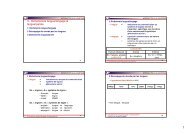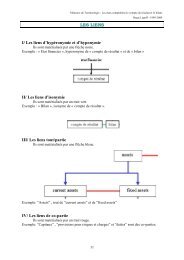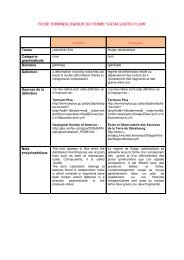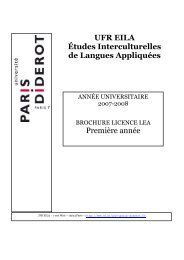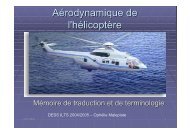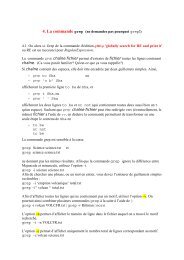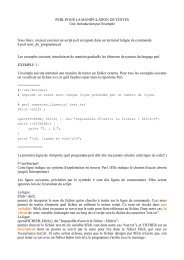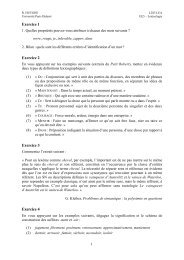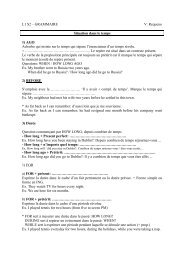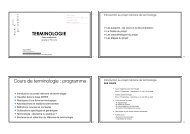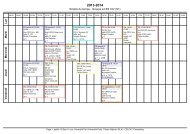INTRODUCTION TO ENGLISH TEXT LINGUISTICS
INTRODUCTION TO ENGLISH TEXT LINGUISTICS
INTRODUCTION TO ENGLISH TEXT LINGUISTICS
You also want an ePaper? Increase the reach of your titles
YUMPU automatically turns print PDFs into web optimized ePapers that Google loves.
Professor Christopher Gledhill<br />
(Notes de cours, Linguistique du texte anglais, 48LGAN23, EILA, Université Paris Diderot)<br />
<strong>TO</strong>PIC 5. LANGUAGES FOR SPECIFIC PURPOSES (LSP)<br />
5.1 The Register and Lexicogrammar of Science Writing.<br />
Most people are familiar with the stereotypical features of specialised science writing. For<br />
example, verbs are typically expressed in the passive: the thermostat beaker was filled with the<br />
buffer solution, CoA-transferase brains were homogenized in 10-mM-Tris and so on. Similarly,<br />
scientific texts are also typically strewn with arcane symbols and terminology, ranging from rather<br />
evocative technical verbs such as elute, eluted, eluting (meaning ‘dissolve’), elongated compound<br />
nouns such as Spirocyclopropanobarbiturates, adipose tissue lipoprotein lipase as well as complex<br />
terms with graphic and numeric insertions or ‘enclitics’ such as 2,2’,5’-Trihydroxy-4,5-<br />
methylenedioxybiphenyl... While the ‘passive’ and ‘nominalisation’ are highly visible features of<br />
scientific language, it is also important to realise that different specialisms have evolved their own<br />
distinct terminological systems and stylistic conventions (or ‘phraseology’ as we see in the next<br />
seminar). Furthermore, linguists such as S. Pavel (1993) and J. Peason (1998) have shown that<br />
science writing is more dynamic than previously assumed, and that different texts and parts of<br />
texts within scientific discourse have very different properties. Thus the terminology; style and<br />
phraseology of specific specialisms varies in much the same way as it does in other varieties of<br />
English. Science writing is therefore not quite as settled or as homogeneous as might be assumed.<br />
In addition, it is important to realise that any stretch of text is likely to contain several different<br />
stylistic features and to exploit quite a wide range of lexicogrammatical resources. The following<br />
sample (from a paper published in Tetrahedron Letters) demonstrates this point rather well:<br />
Although there are several procedures for the preparation of chiral pyrrolidines and<br />
pyrrolidinomes, the majority of these exhibit poor enantiomeric excesses, lack<br />
versatility, suffer low yields or some combination thereof. Herein, we describe an<br />
efficient asymmetric system of substituted pyrrolidines and pyrrolidinomes that<br />
should find general applicability to a variety of modern synthetic challenges.<br />
(J. Gardiner, 1992 ‘Total synthesis of Didehydrodideoxythymidine d4T’ Tetrahedron<br />
Letters).<br />
This text has some predictable features of scientific prose and at the same time has a very<br />
distinctive style, which we would not necessarily associate with science writing, or even with<br />
everyday, modern English. The cohesive devices thereof and herein might strike some readers as<br />
old-fashioned or overly legalistic. At the same time, some common and perfectly recognisable<br />
English words have taken on a specialised meaning in novel lexical collocations (exhibit excesses,<br />
lack versatility, suffer low yields, find general applicability). Thus you can see that the English of<br />
science (or rather we should say the English of synthetic chemistry) has not only developed a very<br />
specific vocabulary and grammar, or in other words, its own specific Register and Lexicogrammar.<br />
We introduced these terms at the beginning of the course, and it is time to return to them here.<br />
You will remember that Michael Halliday refers to Registers (such as ‘the language of science,<br />
29 / 37




